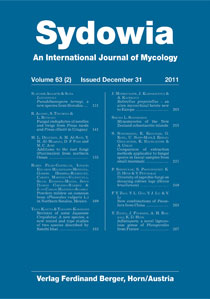
Comparison of extraction methods applicable to fungal spores in faecal samples from small mammals Schickmann S., Kräutler K., Kohl G., Nopp-Mayr U., Krisai-Greilhuber I., Hackländer K. & Urban A. (2010) Comparison of extraction methods applicable to fungal spores in faecal samples from small mammals. Sydowia 63(2): 237–247 Mycophagy is often underestimated as dietary strategy, but forms an important part of the webs of life, especially in forest ecosystems. The identification of consumed fungal species is crucial to gain more knowledge about food web structures. DNA based methods are the way of choice to overcome limitations of species determination by microscopic analysis. DNA extraction from fungal spores in faecal samples requires specific methodology, due to the resistance of fungal spores and due to the properties of the faecal matrix. Keywords: mycophagy, dietary ecology, DNA isolation, environmental microbiology |
 |
Print ISSN: 0082-0598 |